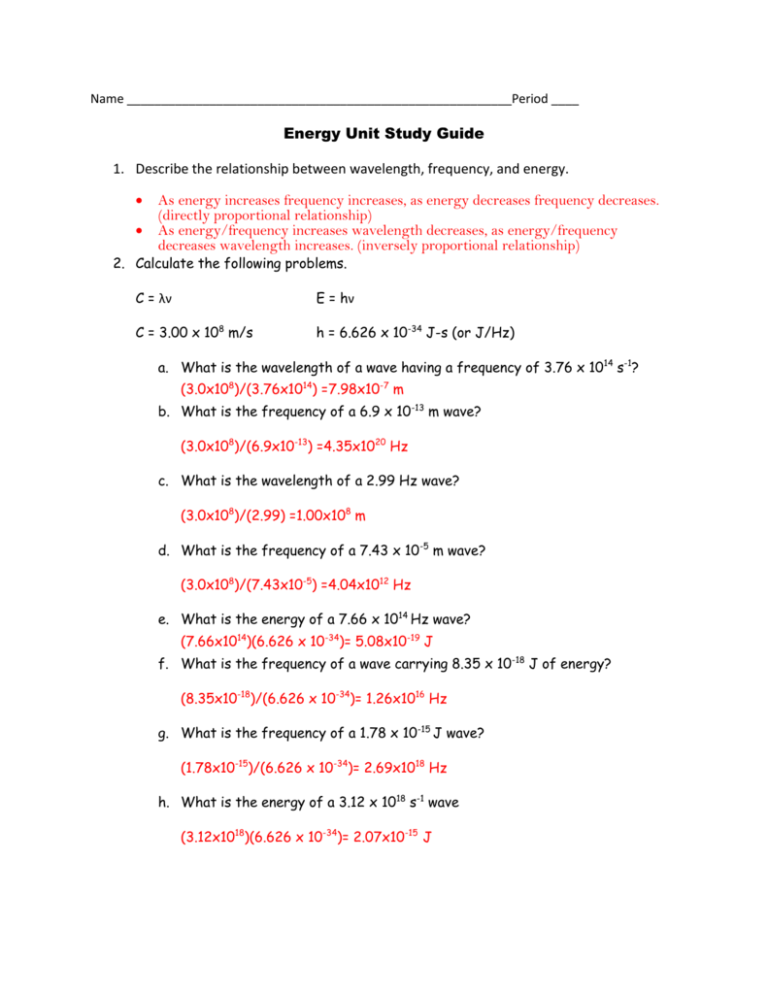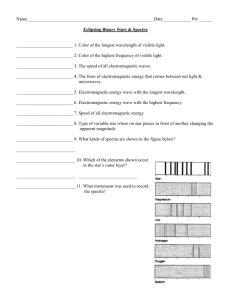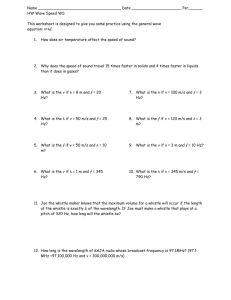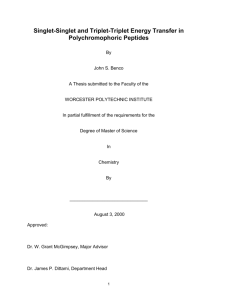Name ____ Energy Unit Study Guide Describe the relationship
advertisement

Name ________________________________________________________Period ____ Energy Unit Study Guide 1. Describe the relationship between wavelength, frequency, and energy. As energy increases frequency increases, as energy decreases frequency decreases. (directly proportional relationship) As energy/frequency increases wavelength decreases, as energy/frequency decreases wavelength increases. (inversely proportional relationship) 2. Calculate the following problems. C = λν E = hν C = 3.00 x 108 m/s h = 6.626 x 10-34 J-s (or J/Hz) a. What is the wavelength of a wave having a frequency of 3.76 x 1014 s-1? (3.0x108)/(3.76x1014) =7.98x10-7 m b. What is the frequency of a 6.9 x 10-13 m wave? (3.0x108)/(6.9x10-13) =4.35x1020 Hz c. What is the wavelength of a 2.99 Hz wave? (3.0x108)/(2.99) =1.00x108 m d. What is the frequency of a 7.43 x 10-5 m wave? (3.0x108)/(7.43x10-5) =4.04x1012 Hz e. What is the energy of a 7.66 x 1014 Hz wave? (7.66x1014)(6.626 x 10-34)= 5.08x10-19 J f. What is the frequency of a wave carrying 8.35 x 10-18 J of energy? (8.35x10-18)/(6.626 x 10-34)= 1.26x1016 Hz g. What is the frequency of a 1.78 x 10-15 J wave? (1.78x10-15)/(6.626 x 10-34)= 2.69x1018 Hz h. What is the energy of a 3.12 x 1018 s-1 wave (3.12x1018)(6.626 x 10-34)= 2.07x10-15 J 3. What is electromagnetic radiation? 4. 5. 6. 7. 8. Energy that moves through space and matter both in the form of magnetic and electric waves and in the form of a stream of particles. Describe the different types of electromagnetic radiation found on the electromagnetic spectrum. Radiowaves Lowest frequency and energy, longest wavelength, used by radiostations and televisions. Microwaves Used in communications and cooking. Used in Cell phones. Infrared Heat you feel from a fire or electric heater. Ex. –Fry warmer Visible Light Only part of the electromagnetic spectrum that we can see with the naked eye. ROY G. BIV Ultraviolet The part of the sunlight that caused sunburns. Used in tanning beds X-rays Type of radiation that passes through soft tissue but is stopped by bone. Allows for a picture of a bone to be taken (x-ray) Gamma Ray Highest energy and frequency, shortest wavelength, Used in cancer treatment. Why have the theories about the shape and structure of an atom changed? Why do they continue to change? They have changed as scientists have made more discoveries about the atom. They continue to change because technology has allowed us to learn so much more about the atom. How are the colors of the continuous spectrum related to wavelength and energy? The colors are arranged according to the wavelength and energy that is associated with them. Red has the lowest amount of energy and the longest wavelength. Violet has the highest amount of energy and the shortest wavelength. The colors in between are arranged according to energy and wavelength. Red, Orange, Yellow, Green, Blue, Indigo, Violet How are photons of light directly related to the amount of energy absorbed by an atom? The color that is emitted is directly proportional to the amount of energy that is absorbed by the atom. Red =lower amount of energy Violet=higher amounts of energy How can the spectra of an unknown gas be used to identify the element? By looking at the spectra of known gases we are able determine the type of gas. Each element has its unique spectra that can be compared to the spectra of the unknown gas. If the spectra match, you can know the type of gas. 9. How can scientist use spectral analysis to identify the elements found in those stars? They can use the spectra of the star and compare it to the spectra of the known elements on Earth. If the known spectra match the stars spectra, then that element is found in the star. 10. Identify which of the elements listed below are found in Star A and which elements are found in Star B. Star A= Sodium, Hydrogen and Helium Star B= Mercury, Hydrogen, and Helium 11. Know how to write the electron configurations and orbital diagrams of different elements. Complete the attached worksheet to review.








